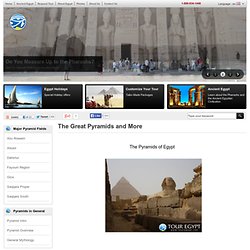

Les principales Pyramides. Définition Le mot pyramide vient du Grec : pyramis πυραμίς au pluriel pyramidis, indiquant un gâteau de farine de blé, qui avait la forme d'une pyramide.

Certains historiens pensent que le mot Grec lui-même vient du mot Égyptien per-em-nous qui, dans le papyrus Rhind, est utilisé pour représenter la hauteur de la pyramide (littéralement "ce qui monte"). Le bâtiment par lui même était appelé mer en Égyptien. Les pyramides Égyptiennes sont à base carrée et, à l'exception de celles de la IIIe dynastie (2647-2575), s'intensifièrent avec une base rectangulaire. Quatre côtés ont des bords lisses qui relient la base au sommet, où se trouvait le pyramidion. Egyptian pyramids found by infra-red satellite images. Seventeen lost pyramids are among the buildings identified in a new satellite survey of Egypt.

More than 1,000 tombs and 3,000 ancient settlements were also revealed by looking at infra-red images which show up underground buildings. Initial excavations have already confirmed some of the findings, including two suspected pyramids. The work has been pioneered at the University of Alabama at Birmingham by US Egyptologist Dr Sarah Parcak. She says she was amazed at how much she and her team has found. "We were very intensely doing this research for over a year. "To excavate a pyramid is the dream of every archaeologist," she said. The team analysed images from satellites orbiting 700km above the earth, equipped with cameras so powerful they can pin-point objects less than 1m in diameter on the earth's surface. Infra-red imaging was used to highlight different materials under the surface.
The Pyramids of Giza in Egypt. The age of the first ancient wonders of the world began with the pyramids of Sneferu, he built three pyramids and may have had a hand in others.

His pyramid at Medum began as a step pyramid and was then modified to form the first true pyramid. He built two pyramids at Dahshur one called the Bent Pyramid because its upper part has a shallower angle of inclination than the lower part. Seneferu's Bent pyramid at Dahshur was originally planned as a true pyramid, but its geometry was altered at a point just above half its height.
The angle of incline was decreased from 54º 31' 13'' to 43º 21'. When Khufu, also known as Cheops, became pharaoh one of his first acts was to curtail the growing power of the priesthood. Khufu's pyramid at Giza showing the plan of passages and burial chamber. Some believe that his pyramid at Giza was built by slaves but this is not true.
There are three pyramids at Giza, each of which once had an adjoining mortuary temple. Egyptian Pyramids and Temples of Egypt with Maps. Pyramidales. The Pyramids of Egypt. THE UPUAUT PROJECT. Wikipedia / Pyramids of Egypt. IMHOTEP témoignages sur trois millénaires. Djoser Complex. Saqqara , la pyramide à degrés de Djeser, oeuvre d'Imhotep, Sakkara, Egypt. Egyptian Pyramids: The Great Pyramids and More. There are no more famous ancient sites within Egypt, or for that matter elsewhere in the world, than the Great Pyramids at Giza.

They are, without question, the icon most associated with the Egypt. They have been both the main destination for tourists, and a source of imaginative thought to the world for over three thousand years. However, there are actually over 100 pyramids in Egypt, many of which are relatively unknown to anyone who is not an ancient Egypt enthusiast. All but a very few are grouped around and near the City of Cairo, just south of the Nile Delta. Otherwise, only one royal pyramid is known in southern Egypt (at Abydos), that being the one built by Ahmose, founder of the 18th Dynasty and Egypt's New Kingdom.It may have also been the last royal pyramid built in Egypt. Hence, major pyramids were not built throughout Egypt's ancient history. However, smaller pyramids were constructed, for example in the Deir el-Medina necropolis, by private individuals.
Pyramids evolved. Theories sur le plateau de GUIZEH. MYSTERIEUSES PYRAMIDES. Kheops Project / reconstitution en 3D de la pyramide de Kheops du plateau de Giza en égypte. La Maison de Maat. [Le mécanisme secret de la grande pyramide d'Egypte] Cliquez sur l’image pour visiter ce site.
![[Le mécanisme secret de la grande pyramide d'Egypte]](http://cdn.pearltrees.com/s/pic/th/mecanisme-secret-pyramide-19205854)
NOUVELLES DECOUVERTES. La mission scientifique ScanPyramids, chargée de l’étude muographique. du monument a découvert deux cavités inconnues dans la pyramide de Khéops.

La première serait une sorte de couloir, situé au-dessus de l’entrée de la pyramide sur la face Nord. La seconde serait une cavité se trouvant au-dessus de la Grande Galerie et proche de la Chambre du Roi. Pour mettre au jour l’existence de ces nouvelles cavités, qui n’ont bien évidemment pas encore pu être explorées, les scientifiques de ScanPyramids ont conjugué plusieurs technologies très pointues. C’est tout d’abord à la caméra thermique qu’une anomalie a été détectée au-dessus du l’entrée Nord et de son couloir descendant qui, par un circuit de corridors, mène à la fameuse chambre du Roi. En parcourant la face Nord de la pyramide avec leurs caméras thermiques, les scientifiques n’ont pas obtenu les résultats auxquels ils s’attendaient au niveau des quatre énormes chevrons.
ScanPyramids aurait eu recourt à la muographie. Les chevrons A suivre.